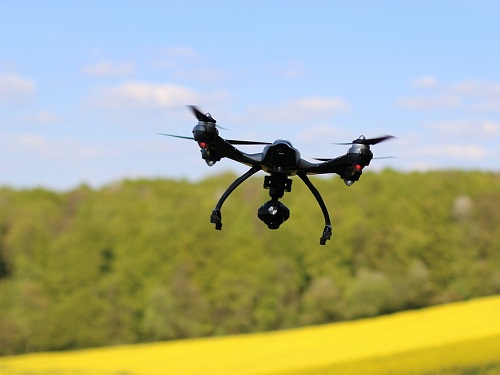- Articles ›
- Operations and IT ›
- Amazon's Flying Fortress- Delivery by Drones Articles
Amazon's Flying Fortress- Delivery by Drones
One of the first companies that comes to our mind when thinking about innovation is Amazon. Amazon wants to be everywhere in your life, right from smart locks in your home to Amazon Go(the grocery store in pilot mode). From Amazon Prime, to delivery via drone, Amazon has expanded and innovated leaps and bound. In December 2016, Amazon became the talk of the town once again when it finally received patent for ‘floating warehouses’. When Amazon finally implements it, we could easily witness the dawn of a new era in e-commerce segment.
But, how exactly does a floating warehouse functions?
The logistics of an e-commerce business consists of goods travelling from the supplier’s warehouse to the fulfilment centre or the central hub where sorting takes place. The goods are then line hauled to the different receiver hub’s in a hub and spoke mechanism. From the receiver hub’s dispatch centre, the goods are finally transported to the respective customers, which is otherwise termed as last mile delivery. For an e-commerce company, the respective cost of the line haul and last mile delivery is approximately 37% to 53% of the total cost of delivery.
To start with, Amazon plans to deploy its warehouse up in the sky with the help of a large balloon where it will store the items for delivery. The flying warehouse will host a swarm of delivery drones, which will carry out deliveries to the customer’s doorstep. The warehouse will be grounded regularly for re-stocking of supplies, after which it will be allowed to go airborne again. With this method, Amazon will be able to deliver goods up to 5 pounds of weight anywhere in a particular city within 30 minutes and reduce the last mile cost to a bare minimum. What’s more, Amazon is making the dream of 100% timely delivery due to no traffic jams right on the rooftop of your home or office.

Image: pixabay
However, the Amazon Prime Air Service does not stop here.
In the long run, Jeff Bezzos and his team plan to install multiple floating warehouses that will keep travelling from cities to cities with an inventory stock that will be based on highly intense data analytics results, covering all the major cities of USA at any particular instance of time. This will not only serve to reduce the last mile costs as discussed above, the long haul costs for goods below 5 pounds of weight will also go down significantly if this system is adopted.
And, what does Amazon gain out of this?
The floating warehouse is supposed to be a beehive frame in comparison to the traditional single story building. This will allow a speedy delivery and reduce the time taken to somewhere in between 30-45 minutes for a package below 5 pounds to be delivered from the time of order. A faster delivery leads to a happier customer, which would mean more revenue for Amazon. The entire process will be automated, so the error due to manual intervention will be reduced considerably. A flying network of Amazon’s warehouses will provide a better reach and distribution network for Amazon.
So, what is the catch?
As impressive, the idea to cover the entire US airspace with Amazon Prime Air warehouses seems, there are few issues that need to be tackled.
While Amazon is trying leaps and bounds to eliminate the two major costs that are prevalent in the e-commerce industry, there are new operating costs that will enter the equation. It remains to seen, how Amazon is planning to lift its warehouse and which gas they will choose to employ. While helium will cost them substantially, hydrogen comes with its own safety issues. From the looks of it, the floating warehouses seem to be unmanned. With self-drive vehicles showing a glimmer of success lately, the success needs to be translated to a self-driven warehouse in the air.
The airspace of USA contains several No Fly Zones and lately, those regulations are expanding to include drones. So, there will be patches in the US map, where Amazon Prime Air will not be able to deliver.
The future?
Experts claim that many a times, a company gets an idea patented only because it seems splendid at the time, never to be used again, thanks to the operational complications or astronomical costs. However, considering the competitors are in awe of Amazon’s intent with Walmart also applying for similar patent, the Amazon Prime Air looks more to be more of a strategic first mover’s advantage than another failed concept for the future.
It does not seem long when we would be watching our team play in its home stadium, while getting our snacks and jerseys delivered by Amazon drones. This technology is not a change but a transformation in the e-commerce operations, which has been the USP of Amazon since long.
This article has been authored by Ali Shaan Haider and Puneet Kathuria
References:
https://jrupprechtlaw.com/amazon-drone-delivery-3-major-legal-problems-amazon-prime-air
https://www.bringg.com/blog/opinions/challenges-last-mile-delivery-serving-e-commerce/
http://cerasis.com/2014/04/30/e-commerce-logistics/
http://unctad.org/meetings/en/Presentation/dtl_eWeek2017p20_MarianneRowden_en.pdf
https://www.theguardian.com/technology/2017/jun/26/amazon-drones-delivery-beehive-patent
https://thenextweb.com/tech/2017/08/24/amazon-patent-details-the-scary-future-of-drone-delivery/
Views expressed in the article are personal. The articles are for educational & academic purpose only, and have been uploaded by the MBA Skool Team.
If you are interested in writing articles for us, Submit Here
Share this Page on:
What is MBA Skool?About Us
MBA Skool is a Knowledge Resource for Management Students, Aspirants & Professionals.
Business Courses
Quizzes & Skills
Quizzes test your expertise in business and Skill tests evaluate your management traits
All Business Sections
Write for Us